Chief Fred Mitchell and the Georgetown Fire Department encourage residents to test their smoke and carbon monoxide alarms when setting their clocks back for daylight saving time.
Daylight saving time ends on Sunday, Nov. 1, at 2 a.m., and clocks will move back one hour at that time.
“Working smoke alarms and carbon monoxide alarms are vital during an emergency, alerting residents when they need to evacuate their home,” Chief Mitchell said. “Daylight saving time serves as a great opportunity to ensure the devices are working properly. We also encourage residents to check on their smoke and carbon monoxide alarms frequently throughout the year.”
According to the International Association of Firefighters (IAFF), working smoke alarms decrease the risk of dying in home fires by nearly half. Additionally, in many reported home fires in which smoke alarms were present but did not operate, the batteries had been removed or the alarm was disconnected due to dead battery alerts or nuisance alarms.
The National Fire Protection Association reports that three of every five home fire deaths resulted from fires in homes with no smoke alarms (38%) or no working smoke alarms (21%). Additionally, dead batteries caused one-quarter (24%) of the smoke alarm failures.
The Georgetown Fire Department also asks that all business owners not only change their clocks, but also change the batteries in their smoke and carbon monoxide alarms, and replace the batteries on wall mounted emergency lights and exit signs. All businesses should have emergency backup lighting as a safety feature to provide temporary lighting in case of power failure.
In order to keep your family and home safe, Georgetown Fire recommends that residents follow safety tips outlined by IAFF:
- Install smoke alarms inside each bedroom, outside each sleeping area and on every level of the home, including the basement. On levels without bedrooms, install alarms in a central location or near the stairway to the upper level. Smoke alarms should be installed at least 10 feet from cooking appliances to minimize false alarms.
- CO alarms should be installed in a central location outside each sleeping area and on every level of the home and in other locations where required by applicable laws, codes or standards. Standard smoke alarms do not detect carbon monoxide.
- CO is known as the invisible killer, it is colorless and odorless. It may also affect adults, children and pets differently.
- For the best protection, interconnect all smoke alarms. When one smoke alarm sounds they all sound. CO alarms can also be interconnected.
- Test smoke and CO alarms at least once per month using the test button.
- Smoke alarms with non-replaceable 10-year batteries are designed to remain effective for up to 10 years. If the alarm chirps warning that the battery is low, replace the entire smoke alarm right away.
- Smoke and CO alarms with replaceable batteries need a new battery at least once per year. Replace batteries during daylight saving time or if the alarm chirps warning that the battery is low.
- When replacing a battery, follow the manufacturer’s list of usable batteries on the back of the alarm. Manufacturer instructions are specific to the batteries that must be used and the alarm may not work properly if a different kind of battery is used.
- Replace all smoke alarms according to the date on the back or when they reach 10 years old. Replace CO alarms according to the manufacturer’s instructions.
- Make sure everyone in the home understands the sound of a smoke and CO alarm and knows how to respond.
The Georgetown Fire Department would also like to remind residents that carbon monoxide and smoke alarms are not interchangeable and should never be disconnected. The best practice for checking your carbon monoxide and smoke alarms is to do so monthly.
For more information on smoke alarm and CO alarm safety, visit the IAFF website.

